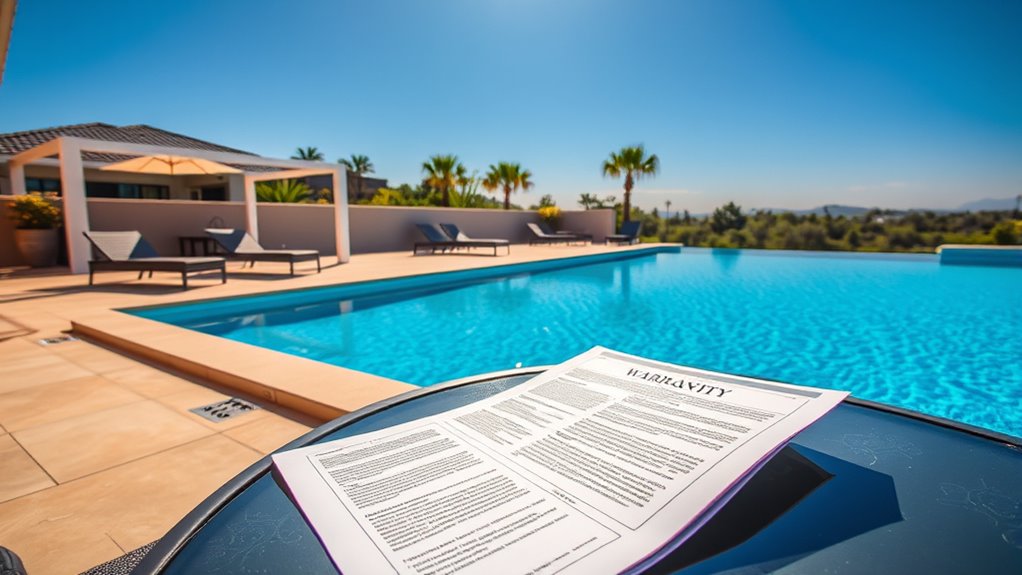To protect your pool investment, you need to understand that warranties cover manufacturer defects and depend on proper maintenance to stay valid. Insurance, on the other hand, guards against accidents, natural disasters, and liability issues. Combining both ensures you’re covered from potential repairs and unforeseen events. Staying proactive with inspections, detailed records, and understanding your policies helps maximize your protection. Keep going to discover how you can best safeguard your pool long-term.
Key Takeaways
- Regular maintenance and inspections are vital to ensure warranty coverage remains valid.
- Read warranty fine print to understand what is covered and avoid voiding it through neglect.
- Insurance protects against accidental damage, liability, and natural disasters beyond warranty scope.
- Combining warranties and insurance provides comprehensive protection for your pool investment.
- Proper documentation and proactive management help maximize benefits and ensure timely claims.

When investing in a pool, understanding warranties and insurance is essential to protect your financial and safety interests. A pool isn’t just a significant upfront expense; it also requires ongoing maintenance to keep it safe, clean, and functional. That’s why knowing what your warranty covers and how insurance can safeguard you is crucial. Warranty coverage typically extends to the pool’s structural components, equipment, and certain parts, but it’s important to read the fine print. Many manufacturers offer warranties that last several years, providing peace of mind that defects or failures won’t drain your budget. However, warranty coverage often doesn’t include routine pool maintenance, which remains your responsibility. Proper pool maintenance, such as regular cleaning, balancing chemicals, and inspecting equipment, helps prevent issues that could void your warranty. If you neglect maintenance, you risk damaging parts or causing problems that aren’t covered under warranty, leading to costly repairs. Regular upkeep also supports your wall organization system, ensuring it remains functional and visually appealing.
Knowing the scope of your warranty can influence how you approach pool maintenance. For example, if your warranty covers pool equipment like filters, pumps, or heaters, you’ll want to perform regular inspections and keep detailed records of any repairs or servicing. This documentation can be crucial if you need to claim warranty coverage later. It’s also wise to schedule professional inspections if required by the warranty terms, ensuring your pool remains in compliance and protected.
Regular inspections and detailed records help protect your warranty coverage and ensure your pool remains compliant.
Insurance plays a different but equally vital role in safeguarding your pool investment. While warranties protect against manufacturer defects, insurance covers accidental damage, liability, and unforeseen events like vandalism or severe weather. A comprehensive homeowner’s policy may include some coverage for pools, but it’s often necessary to add specific endorsements or separate policies to get adequate protection. This ensures you’re covered if, for example, a storm causes damage or someone gets injured while swimming. Remember, insurance isn’t just about protecting the physical pool; it’s about protecting your finances and peace of mind.
Ultimately, understanding how warranties and insurance work together helps you navigate the responsibilities of pool ownership. Regular pool maintenance is key to maximizing warranty coverage and preventing issues that could void it. Meanwhile, proper insurance coverage ensures you’re protected from unexpected costs resulting from accidents or natural disasters. By staying informed and proactive, you can enjoy your pool without undue worry, knowing you’ve taken the necessary steps to safeguard your investment.
Frequently Asked Questions
How Long Do Typical Pool Warranties Last?
A typical pool warranty lasts about 1 to 5 years, depending on the manufacturer and the parts covered. During this time, you’re protected if issues arise from installation or materials. Remember, proper pool maintenance and seasonal closures can help extend your pool’s lifespan. Regular upkeep guarantees warranties stay valid and your investment remains protected, preventing unnecessary repairs and expenses down the line.
Are Pool Warranties Transferable to New Owners?
Think of your pool warranty as a gift with a bow that’s meant to be unwrapped by new owners. Transferability concerns often hinge on the warranty’s terms, with some policies allowing seamless transfer and others hitting limits. Warranty limitations can include time frames or specific coverage exclusions, so it’s crucial to verify if your warranty can be transferred. Always review the fine print to guarantee your investment remains protected as ownership changes hands.
What’s Included in Standard Pool Insurance Coverage?
Standard pool insurance usually covers damages from weather, vandalism, and accidental injuries, helping you maintain pool safety. It often includes liability coverage if someone gets hurt, as well as repairs for equipment and structural issues. To keep your pool in top shape, regular pool maintenance is essential. Make sure you understand what’s included so you’re protected against unexpected costs, ensuring your investment stays safe and your family enjoys a secure swimming environment.
How Do I File a Pool Warranty Claim?
To file a pool warranty claim, start by reviewing your pool warranty process outlined in your documentation. Contact your warranty provider and explain the issue. Be prepared with claim documentation, including photos, receipts, or any proof of defect. Submit your claim promptly, following the provider’s instructions. Stay in contact with the company throughout the process, and keep records of all communications for future reference.
Can Warranties Cover Pool Equipment Upgrades?
Like Pandora’s box, warranties can surprise you. Typically, they don’t cover upgrades or improvements, so pool equipment upgrades often fall under pool maintenance and aren’t included due to warranty exclusions. Before planning upgrades, review your warranty details carefully, as it might only cover repairs for existing equipment. If you want peace of mind, consider additional coverage or extended warranties to protect your investment and avoid unexpected costs.
Conclusion
Think of your pool as a valuable ship sailing through calm and stormy waters alike. Warranties and insurance are your sturdy anchors, keeping you grounded when rough seas threaten to shake your investment. By securing these protections, you’re ensuring your pool remains a safe harbor for years to come. So, equip your ship wisely—because with the right safeguards, your backyard oasis will always be your personal paradise, no matter what waves may come.









